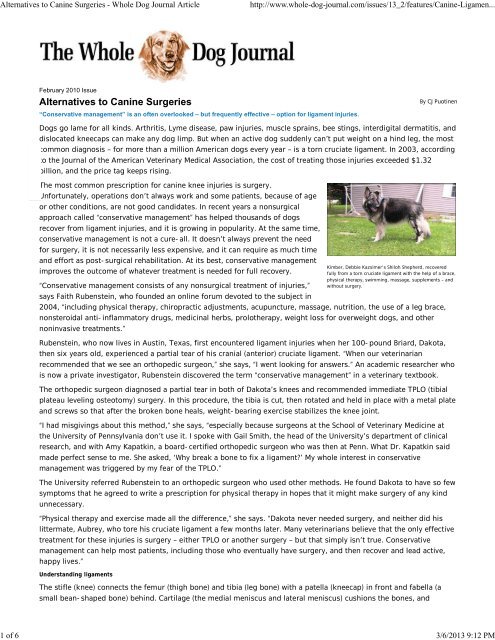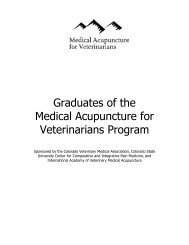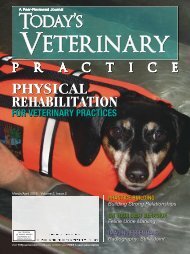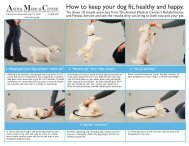Alternatives to Canine Surgeries - Tripawds Downloads
Alternatives to Canine Surgeries - Tripawds Downloads
Alternatives to Canine Surgeries - Tripawds Downloads
You also want an ePaper? Increase the reach of your titles
YUMPU automatically turns print PDFs into web optimized ePapers that Google loves.
<strong>Alternatives</strong> <strong>to</strong> <strong>Canine</strong> <strong>Surgeries</strong> - Whole Dog Journal Articlehttp://www.whole-dog-journal.com/issues/13_2/features/<strong>Canine</strong>-Ligamen...1 of 6 3/6/2013 9:12 PMFebruary 2010 Issue<strong>Alternatives</strong> <strong>to</strong> <strong>Canine</strong> <strong>Surgeries</strong>“Conservative management” is an often overlooked – but frequently effective – option for ligament injuries.By CJ PuotinenDogs go lame for all kinds. Arthritis, Lyme disease, paw injuries, muscle sprains, bee stings, interdigital dermatitis, anddislocated kneecaps can make any dog limp. But when an active dog suddenly can’t put weight on a hind leg, the mostcommon diagnosis – for more than a million American dogs every year – is a <strong>to</strong>rn cruciate ligament. In 2003, according<strong>to</strong> the Journal of the American Veterinary Medical Association, the cost of treating those injuries exceeded $1.32billion, and the price tag keeps rising.The most common prescription for canine knee injuries is surgery.Unfortunately, operations don’t always work and some patients, because of ageor other conditions, are not good candidates. In recent years a nonsurgicalapproach called “conservative management” has helped thousands of dogsrecover from ligament injuries, and it is growing in popularity. At the same time,conservative management is not a cure-all. It doesn’t always prevent the needfor surgery, it is not necessarily less expensive, and it can require as much timeand effort as post-surgical rehabilitation. At its best, conservative managementimproves the outcome of whatever treatment is needed for full recovery.“Conservative management consists of any nonsurgical treatment of injuries,”says Faith Rubenstein, who founded an online forum devoted <strong>to</strong> the subject inKimber, Debbie Kazsimer’s Shiloh Shepherd, recoveredfully from a <strong>to</strong>rn cruciate ligament with the help of a brace,physical therapy, swimming, massage, supplements – andwithout surgery.2004, “including physical therapy, chiropractic adjustments, acupuncture, massage, nutrition, the use of a leg brace,nonsteroidal anti-inflamma<strong>to</strong>ry drugs, medicinal herbs, prolotherapy, weight loss for overweight dogs, and othernoninvasive treatments.”Rubenstein, who now lives in Austin, Texas, first encountered ligament injuries when her 100-pound Briard, Dakota,then six years old, experienced a partial tear of his cranial (anterior) cruciate ligament. “When our veterinarianrecommended that we see an orthopedic surgeon,” she says, “I went looking for answers.” An academic researcher whois now a private investiga<strong>to</strong>r, Rubenstein discovered the term “conservative management” in a veterinary textbook.The orthopedic surgeon diagnosed a partial tear in both of Dakota’s knees and recommended immediate TPLO (tibialplateau leveling osteo<strong>to</strong>my) surgery. In this procedure, the tibia is cut, then rotated and held in place with a metal plateand screws so that after the broken bone heals, weight-bearing exercise stabilizes the knee joint.“I had misgivings about this method,” she says, “especially because surgeons at the School of Veterinary Medicine atthe University of Pennsylvania don’t use it. I spoke with Gail Smith, the head of the University’s department of clinicalresearch, and with Amy Kapatkin, a board-certified orthopedic surgeon who was then at Penn. What Dr. Kapatkin saidmade perfect sense <strong>to</strong> me. She asked, ‘Why break a bone <strong>to</strong> fix a ligament?’ My whole interest in conservativemanagement was triggered by my fear of the TPLO.”The University referred Rubenstein <strong>to</strong> an orthopedic surgeon who used other methods. He found Dakota <strong>to</strong> have so fewsymp<strong>to</strong>ms that he agreed <strong>to</strong> write a prescription for physical therapy in hopes that it might make surgery of any kindunnecessary.“Physical therapy and exercise made all the difference,” she says. “Dakota never needed surgery, and neither did hislittermate, Aubrey, who <strong>to</strong>re his cruciate ligament a few months later. Many veterinarians believe that the only effectivetreatment for these injuries is surgery – either TPLO or another surgery – but that simply isn’t true. Conservativemanagement can help most patients, including those who eventually have surgery, and then recover and lead active,happy lives.”Understanding ligamentsThe stifle (knee) connects the femur (thigh bone) and tibia (leg bone) with a patella (kneecap) in front and fabella (asmall bean-shaped bone) behind. Cartilage (the medial meniscus and lateral meniscus) cushions the bones, and
<strong>Alternatives</strong> <strong>to</strong> <strong>Canine</strong> <strong>Surgeries</strong> - Whole Dog Journal Articlehttp://www.whole-dog-journal.com/issues/13_2/features/<strong>Canine</strong>-Ligamen...2 of 6 3/6/2013 9:12 PMligaments hold everything in position.Two key ligaments, the anterior (front) and posterior (back) cruciate ligaments, cross inside the knee joint. In animals,these ligaments are called cranial and caudal, respectively. The anterior or cranial cruciate ligament prevents the tibiafrom slipping out of position.Veterinarians see most ligament patients immediately after their injuries, when symp<strong>to</strong>ms are acute, or weeks ormonths later, after symp<strong>to</strong>ms become chronic. If not immediately treated, most ligament injuries appear <strong>to</strong> improvebut the knee remains swollen and abnormal wear between bones and meniscal cartilage creates degenerative changesthat result in osteophytes (bone spurs), chronic pain, loss of motion, and arthritis. In some patients, osteophytesappear within one <strong>to</strong> three weeks of a ligament injury. Swelling on the inside of the knee, called a “medial buttress,”indicates the development of arthritis in patients with old injuries.The main diagnostic <strong>to</strong>ols for ligament injuries are X-rays, which can rule out bone cancer as a cause of leg pain, and aprocedure called the “drawer test,” in which the veterinarian holds the femur with one hand and manipulates the tibiawith the other. If the tibia can be moved forward, resembling a drawer being opened, the cruciate ligament has been<strong>to</strong>rn or ruptured.The drawer test is not necessarily conclusive because the tense muscles of a frightened or apprehensive dog canstabilize the knee temporarily. To produce more accurate results in such cases, patients may be sedated before beingtested.In the tibial compression test, which is another way <strong>to</strong> check for ligament damage, the femur is held steady with onehand while the other flexes the dog’s ankle. A ruptured ligament allows the tibia <strong>to</strong> move abnormally forward.“A complete cranial cruciate ligament tear is always a surgical case,” says Stacey Hershman, DVM, of Hastingson-Hudson,New York, “since otherwise the knee cannot function as a hinge joint.” Advocates of conservativemanagement recommend that whenever the tear is partial, nonsurgical techniques be given an eight-week try. Ifsymp<strong>to</strong>ms improve during that time, they say, the odds favor nonsurgical recovery. If symp<strong>to</strong>ms don’t improve,conservative management techniques can be used as pre- and post-operative conditioning and therapy.ýAfter an injuryIf your dog is injured, visit your vet as soon as possible, but be an informed consumer. Many veterinarians considercruciate ligament surgery necessary, routine, fast, easy, highly effective, and the only treatment that will help. For manydogs this has been the case, but some veterinary research (see “Surgical Options,” on page 16) places the ligamentsurgery success rate at well below 50 percent. If surgery is necessary, your investment in conservative managementmay pay dividends in faster recovery and better overall health.<strong>Canine</strong> health and nutrition researcher Mary Straus recommends simple first-aid strategies for dogs with knee injuries.Straus learned about the benefits of such an approach when her dog, Piglet, had surgery for dysplasia on both elbowsbefore her second birthday, followed by surgery for a ruptured cruciate at age three. “First and most importantly,” shesays, “exercise must be restricted. No running, no jumping (including on and off furniture), and no stairs. Walk yourdog on-leash when going outside <strong>to</strong> potty. The dog doesn’t necessarily have <strong>to</strong> be crated, which can restrict movementso much that it increases stiffness and limits flexibility, but should be confined <strong>to</strong> a small room or ex-pen, or kep<strong>to</strong>n-leash while with the owner. Exercise restriction must be continued for at least six <strong>to</strong> eight weeks.”Second, inflammation needs <strong>to</strong> be controlled. “I would use nonsteroidal anti-inflamma<strong>to</strong>ries (NSAIDs),” she says.“Inflammation contributes <strong>to</strong> cartilage degeneration and accelerates the development of arthritis. Don’t avoid NSAIDs inthe hope that pain will keep your dog from overusing the leg. There are natural anti-inflamma<strong>to</strong>ries like bromelain,boswellia, quercitin, and turmeric, and I would use those as well, but they may not be strong enough alone. You coulduse white willow bark, which is comparable <strong>to</strong> aspirin, but it should not be combined with other NSAIDs. In addition <strong>to</strong>anti-inflamma<strong>to</strong>ries, I would give glucosamine-type supplements <strong>to</strong> try <strong>to</strong> protect the cartilage and slow arthriticchanges. It’s questionable how much these help with cruciate injuries, but they do no harm and I would include them.”Dr. Hershman prescribes Glycoflex, a nutritional supplement that contains freeze-dried Perna canaliculus or NewZealand Green Lipped Mussel. This product is recommended for joint and connective tissue support, for geriatric andworking dogs, and as a follow-up <strong>to</strong> orthopedic surgery.In addition, she gives subcutaneous Adequan® injections or teaches the owners <strong>to</strong> do so at home. Adequan <strong>Canine</strong>(polysulfated glycosaminoglycan) is a prescription, water-based, intramuscular, polysulfated glycosaminoglycan that
<strong>Alternatives</strong> <strong>to</strong> <strong>Canine</strong> <strong>Surgeries</strong> - Whole Dog Journal Articlehttp://www.whole-dog-journal.com/issues/13_2/features/<strong>Canine</strong>-Ligamen...3 of 6 3/6/2013 9:12 PMhelps prevent cartilage in the dog’s joint from wearing away. “I give injections twice a week for two weeks,” says Dr.Hershman, “then once a week for maintenance.”She also recommends Wholistic <strong>Canine</strong> Complete Joint Mobility, which is apowder containing organic vitamins, minerals, digestive enzymes, hydrolizedwhitefish, immune-support ingredients, and pharmaceutical-gradeglucosamine, chondroitin and MSM (methyl sulfonyl methane), all of whichsupport healing, speed tissue repair, or help alleviate pain and inflammation.Standard Process products for improved ligament health include Ligaplex, whichcontains organic raw bone, herbs, and minerals, and the veterinary product<strong>Canine</strong> Musculoskeletal Support, which contains anti-inflamma<strong>to</strong>ry herbs, Pernacanaliculus, and whole-food ingredients that enhance tissue regeneration andimprove joint health.It is important <strong>to</strong> keep injured dogs from gaining weight, which can easilyhappen when their exercise routine is interrupted. “Overweight dogs have aharder time recovering from a cruciate ligament injury,” says Straus, “and theyare more at risk for injuring the other knee. I would feed a high-protein,low-carbohydrate, reduced-fat diet. Fat is high in calories and so should beBoth of Faith Rubenstein’s Briards, Dakota and Aubrey,<strong>to</strong>re a cruciate ligament at different times – turning Faithin<strong>to</strong> something of an expert on dealing with the injury!limited, but <strong>to</strong>o little fat will leave the dog feeling hungry all the time. Protein helps with wound healing and also <strong>to</strong>create and preserve lean muscle, while carbs are more likely <strong>to</strong> be s<strong>to</strong>red as fat. For those who feed kibble, I would cutback on the amount fed and add fresh, high-protein foods such as eggs, meat, and dairy. For seriously overweightdogs, this is one situation where I might consider using the drug Slentrol <strong>to</strong> help speed weight loss.”Physical therapyFaith Rubenstein’s Dakota received physical therapy from Carol Wasmucky, PT, a licensed physical therapist for humansin Herndon, Virginia, who founded Pet Rehab Inc. and works full-time with animals by referral from veterinariansthroughout Northern Virginia.She began Dakota’s treatment by measuring his hind legs, one of which had atrophied and was smaller than the other.“Our goal,” says Rubenstein, “was <strong>to</strong> have both legs measure the same. Dakota and I worked with a holistic veterinarian,who put him on nutritional and herbal supplements, and we did acupuncture as well. I restricted his activity so he wasnot allowed <strong>to</strong> run off-leash for six months, and during that time he had regular physical therapy. Dakota wasn’t aswimming dog but he became one, for swimming was the perfect exercise for him. After six months, both hind legswere the same 17 inches in girth. He was in great shape, his drawer test results improved <strong>to</strong> nearly normal, and hedidn’t need surgery.”Dogs who are intermittently lame with a partial tear of the cruciate ligament are ideal physical therapy patients, saysWasmucky. In addition <strong>to</strong> providing weekly or twice-a-week ultrasound, laser, and electrical stimulation treatments,she puts patients on a home strengthening program with range-of-motion and stretching exercises. “Every program isdifferent depending on the dog’s condition,” she says. “The owners are involved every day; I show them what <strong>to</strong> do. It’sjust like working with human injuries; if you want the best results, you have <strong>to</strong> do your homework.”Wasmucky, who has worked with thousands of canine patients over the past 10 years, encourages anyone whose doghas a partial tear <strong>to</strong> use physical therapy <strong>to</strong> build muscle so that even if surgery has <strong>to</strong> be performed, the dog goes inand comes out in better shape. “This means shorter rehab time,” she says, “and a faster recovery.”Swimming is such effective exercise for injured dogs that many veterinary clinics have installed swimming pools. “Dogswho can’t yet do weight-bearing exercises can start in a pool,” she says, “and as they get stronger, they’re able <strong>to</strong>progress through the exercise program. I check their progress in weekly appointments and make adjustments asneeded. It takes time <strong>to</strong> heal from ligament injuries and I like <strong>to</strong> be sure that dogs are completely well before theyresume agility or other demanding sports.”She requires a major commitment from owners. “It’s usually an hour or so every day in twice-a-day sessions,” she says,“and this can go on for months. It’s a big investment of time and energy, and it requires a motivated dog as well as amotivated owner, but it can make a world of difference in mobility and overall health.” For more about caninerehabilitation, see “<strong>Canine</strong> Rehab? Go, Go, Go” (Whole Dog Journal September 2009).Prolotherapy
<strong>Alternatives</strong> <strong>to</strong> <strong>Canine</strong> <strong>Surgeries</strong> - Whole Dog Journal Articlehttp://www.whole-dog-journal.com/issues/13_2/features/<strong>Canine</strong>-Ligamen...4 of 6 3/6/2013 9:12 PMAlthough most veterinary experts agree that there is no way <strong>to</strong> repair a damaged ligament, one alternative therapyclaims <strong>to</strong> do exactly that. Prolotherapy, also known as proliferative or sclerosing therapy, has been used for over 30years <strong>to</strong> treat musculoskeletal pain in humans, including arthritis, sports injuries, and damaged or partially <strong>to</strong>rnligaments, tendons, and cartilage.The term “prolo” is short for proliferation, as this treatment is said <strong>to</strong> cause the proliferation (growth or formation) ofnew tissue in weakened areas. Ligaments have a limited blood supply, which slows healing, but in prolotherapy,injections of dextrose (sugar water) or other benign substances cause localized inflammation that increases the supplyof blood and nutrients, stimulating tissue repair.Health columnist Jane E. Brody described prolotherapy as “injections <strong>to</strong> kick-start tissue repair” in the August 7, 2007,New York Times, where she wrote that most scientifically designed controlled studies of prolotherapy have shown “asignificant improvement in the patients’ level of pain and ability <strong>to</strong> move the painful joint.” In studies of human kneeinjuries, she said, patients with ligament laxity and instability experienced a tightening of those ligaments, includingthe anterior cruciate ligament. Other studies showed a significant improvement in the symp<strong>to</strong>ms of arthritis in the kneeone <strong>to</strong> three years after prolotherapy injections.In Royal Oak, Michigan, John Simon, DVM, uses prolotherapy <strong>to</strong> repair damaged cruciate ligaments in dogs. Heexplains, “Prolotherapy is a way of tightening up loose, unstable, hyper-mobile joints by injecting a ‘sclerosing’ agentin and around the joint. The resulting thickening of the joint capsule and the ligaments surrounding it act like scartissue and eventually contract with time. The thickening and contraction of the ligaments and joint capsule increasejoint stability and relieve joint pain.”Most canine patients receive five sessions at three-week intervals. “Although I tell caregivers not <strong>to</strong> expect any positiveresults until at least the third treatment,” he says, “I am occasionally surprised <strong>to</strong> see improvement after just one. Othermodalities that I often recommend in conjunction with prolotherapy are soft laser therapy and pulse magnetic therapy.These treatments reduce pain and help the joint recuperate.”According <strong>to</strong> Dr. Simon, the best candidates for prolotherapy ligament repair are dogs whose injuries do not involve<strong>to</strong>rn meniscal cartilage in the joint. During the past three years, he has treated 35 dogs for cruciate ligament problemsand estimates that 80 percent experienced significant improvement.ýBracing for recoveryDebbie Kazsimer, who lives in Pennsylvania, knows a lot about cruciate ligaments. Trouble, her Shepherd/Husky mix,had TPLO surgeries at ages six and seven, and her Shepherd/Malamute mix, Fly, had a TPLO when she was two.In 2005, the Journal of the American Veterinary Medical Association published the case of a German Shepherd Dog whodeveloped bone cancer after her implant corroded (“Sarcoma of the proximal portion of the tibia in a dog 5.5 yearsafter tibial plateau leveling osteo<strong>to</strong>my,” JAVMA, November 15, 2005, Vol. 227, No. 10). Two years later, Trouble wasdiagnosed with osteosarcoma, and when his leg was amputated, its metal implant was found <strong>to</strong> be corroded. Thebiopsy report linked the cancer <strong>to</strong> his 2004 TPLO surgery.As a precaution, Kazsimer had Fly’s implant removed. “But by then five yearshad passed and it was <strong>to</strong>o late,” she says. “The damage was already done.”Within months, both dogs died of osteosarcoma.Four weeks after Fly’s death, Kazsimer’s six-year-old 100-pound ShilohShepherd, Kimber, <strong>to</strong>re a cruciate ligament. By then, Kazsimer had learnedabout conservative management and knew she didn’t want <strong>to</strong> put another dogthrough a TPLO surgery. Because of her experiences with Fly and Trouble, shewas familiar with range-of-motion and physical therapy exercises, and shestudied massage with her husband, Ken, an Integrated Touch Therapy caninemassage therapist. She spent an hour or two daily on Kimber’s rehabilitation.“I thought a leg brace would be a big help <strong>to</strong> her,” she says, “but my veterinarianrefused <strong>to</strong> fit her for one because he was convinced it wouldn’t work. So myhusband and son helped me <strong>to</strong> cast her leg with a casting kit from Orthopets.The brace supports the knee externally, just as surgery supports it internally.”Kimber went from walking on three legs <strong>to</strong> walking on four, then swimming,
<strong>Alternatives</strong> <strong>to</strong> <strong>Canine</strong> <strong>Surgeries</strong> - Whole Dog Journal Articlehttp://www.whole-dog-journal.com/issues/13_2/features/<strong>Canine</strong>-Ligamen...5 of 6 3/6/2013 9:12 PMthen finally bearing full weight on her leg. Eight months after her injury,Kimber’s regimen of supplements, physical therapy, massage, swimming, andNutmeg recovered from two ACL tears without surgery.wearing the brace have enabled her <strong>to</strong> recover well without surgery. “She runs around like a wild girl!” says Kazsimer,who has posted videos of Kimber online, where you can see her running, swimming, and playing with and without herbrace on. “It’s wonderful,” she says. “Kimber is able <strong>to</strong> do everything she did before she got hurt.”Holistic therapiesThe most popular “hands-on” treatments for injured dogs include acupuncture, acupressure, chiropractic, andmassage.Dr. Hershman, a certified veterinary acupuncturist, treats patients with acupuncture <strong>to</strong> alleviate pain and enhancehealing of the <strong>to</strong>rn ligament. “I do this once or twice per week for the first two weeks,” she says, “depending on thedog’s level of pain, then once a week for five <strong>to</strong> six weeks, then once every two weeks, and finally once a month. Whenthe dog is weight-bearing and in less pain, I s<strong>to</strong>p.” Dr. Hershman is also a certified veterinary homeopath whoprescribes homeopathic remedies according <strong>to</strong> the patient’s symp<strong>to</strong>ms.In their article “Post-op Acupressure” (August 2006), Nancy Zidonis and Amy Snow describe how stimulating specificacupressure points with a thumb or fingertip can help with pain management, clear the effects of anesthesia, minimizethe building of scar tissue, and reduce swelling. Acupressure can be learned at home and applied whenever needed.Veterinary chiroprac<strong>to</strong>rs help speed the healing of injuries and surgeries by making adjustments that improve skeletalalignment and musculoskeletal function. (See “Chiroprac<strong>to</strong>rs for <strong>Canine</strong>s,” March 2008.) Chiropractic adjustments helpres<strong>to</strong>re normal nerve activity by gently moving bones, ligaments, and tendons back in<strong>to</strong> alignment, and when ligamentsare injured, adjustments help realign the body <strong>to</strong> improve balance and speed healing.<strong>Canine</strong> massage therapists used <strong>to</strong> be unusual, but now they play an important role in maintaining and improving ourdogs’ health. Efflurage, passive <strong>to</strong>uch, kneading techniques, and stroking increase circulation, release muscle tension,reduce pain and soreness, relieve stress, and accelerate the repair process. Massage books and how-<strong>to</strong> videos make iteasy for caregivers <strong>to</strong> apply these same techniques at home.Online supportThanks <strong>to</strong> the Internet, anyone whose dog suffers a cruciate ligament injury can find a wealth of information aboutcanine ana<strong>to</strong>my, surgical options, and alternative therapies online.The conservative management forum that Faith Rubenstein founded five years ago now has more than 2,000 membersaround the world. Paola Ferraris, who lives in Italy, is one of its modera<strong>to</strong>rs. “What I would like <strong>to</strong> stress is thatconservative management is not an easy (and often not cheap) alternative <strong>to</strong> surgery,” says Ferraris. “Successfulconservative management requires just as much commitment as post-op care. It’s <strong>to</strong>ugh love and careful management.Your work is basically the same as rehabbing a dog who has had surgery; in fact, a number of our members have hadsurgery done on their dogs and use the list for pre-op and post-op support.”When her own dog suffered a ligament injury, Ferraris had <strong>to</strong> make decisions with little information. “The best way <strong>to</strong>discuss treatment with your veterinarian is when you understand the available options and their pros and cons,” shesays. “I had <strong>to</strong> educate myself by spending nights doing research online, after the fact. I would have appreciated havingmore available information, which is what we now offer.”Co-modera<strong>to</strong>r Ansley New<strong>to</strong>n of Pownal, Maine, became interested in conservative management when her chocolateLab, Dooley, injured his second knee. “The first knee had TPLO surgery,” she says, “so I was excited <strong>to</strong> try conservativemanagement with the second knee.Unfortunately after four months he did not get better and I chose <strong>to</strong> have a traditional surgery, which was verysuccessful for this 90-pound dog. Then one day my large chocolate Lab, Nutmeg, came inside with that familiar limp. Iagain decided <strong>to</strong> try conservative management along with a knee brace, acupuncture, massage, swimming, and someother supportive techniques. Within six months she was back <strong>to</strong> normal with very little arthritis.“After three ligament injuries, I thought I was done. But no, two years later Nutmeg came in limping again. I again wentthe conservative management route and things were going fine until the second month when Nutmeg had an oopsmoment. She was limping again, so I decided <strong>to</strong> do surgery but had <strong>to</strong> postpone it for a couple of months because I<strong>to</strong>re my own anterior cruciate ligament and damaged my meniscus at the same time!“So here I was running a farm by myself on crutches and wearing a knee brace with a dog in a knee brace. What a sightwe both were. I wish I had taken a picture. We were forced <strong>to</strong> stay with conservative management because there was no
<strong>Alternatives</strong> <strong>to</strong> <strong>Canine</strong> <strong>Surgeries</strong> - Whole Dog Journal Articlehttp://www.whole-dog-journal.com/issues/13_2/features/<strong>Canine</strong>-Ligamen...6 of 6 3/6/2013 9:12 PMone <strong>to</strong> take care of the farm and I couldn’t drive Nutmeg <strong>to</strong> get her surgery. We limped through several months<strong>to</strong>gether and lo and behold, we both healed. Nutmeg was good <strong>to</strong> go in six months and it <strong>to</strong>ok me closer <strong>to</strong> 10.Nutmeg recently passed away from lymphoma. She was 14 years old and despite those two ligament injuries, her legswere still fine.”CJ Puotinen is a long-time contribu<strong>to</strong>r <strong>to</strong> WDJ and author of The Encyclopedia of Natural Pet Care and Natural Remedies for Dogs and Cats.Read More on These TopicsDog Health & Care Puppy Health Skin & Coat Surgery© 2013 Belvoir Media Group, LLC. All rights reserved.






